Aspect Analysis: Spurs’ stellar defence tops Dortmund
Tottenham met Borussia Dortmund at Wembley on Wednesday Night in the opening round of the Champions League Group Stage. The Germans travelled to London undefeated under new manager Peter Bosz, whilst Spurs were keen to eradicate their ‘Wembley blues’ after a mixed start to their season.
As ever with a Bosz side, Dortmund operated in a fluid 4-3-3 formation, whilst the home team lined up on paper in a 5-3-2/5-2-3 shape. Despite BVB having two thirds of the match’s possession, their attacks were nullified by Tottenham’s exceptional defending, allowing Pochettino’s side to control the match and emerge as victors. Therefore, this analysis will focus on Spurs’ defensive performance.
High Press
Spurs were keen to impose themselves at the start of the match, and began at a high tempo. Their defensive line was relatively high, and they were keen to pressurise the Dortmund defence and disrupt their build-up, which was primarily down the left side of the field. There were numerous man-orientations between Tottenham and Dortmund’s players created as a result of Tottenham’s initial approach. Both Eriksen and Son supported Kane in pressurising the goalkeeper and centre-backs. They tucked inside into the half spaces to limit access to Dortmund’s CM’s in the centre of the pitch, especially Sahin and Dahoud. In the early moments of the match, Kane in particular would pressurise the CB’s by using his cover shadow to mark one of the two CB’s, making horizontal ball circulation more difficult. This is a staple of Bosz’s team’s build-up play, so this was indeed a disruption to the Germans. When the ball was recycled to Burki, Kane was in a situation to be able to press the Swiss GK, as Son and Eriksen pushed up to mark the BVB CB’s, with Dembele and Dier also moving up the pitch to maintain vertical compactness. This forced Burki to play long kicks forward, usually resulting in a loss of possession. Tottenham’s front three was interchangeable, and Son or Eriksen would find themselves in a central position at times, as in the scenario below.
Whilst Eriksen and Son were tucked inside, Aurier and Davies, particularly the latter, covered BVB’s FB’s Toljan and Piszczek. Indeed, Davies positioning and timing of his defensive actions towards Piszczek were extremely well done, and build-up play almost never passed through the Polish international.
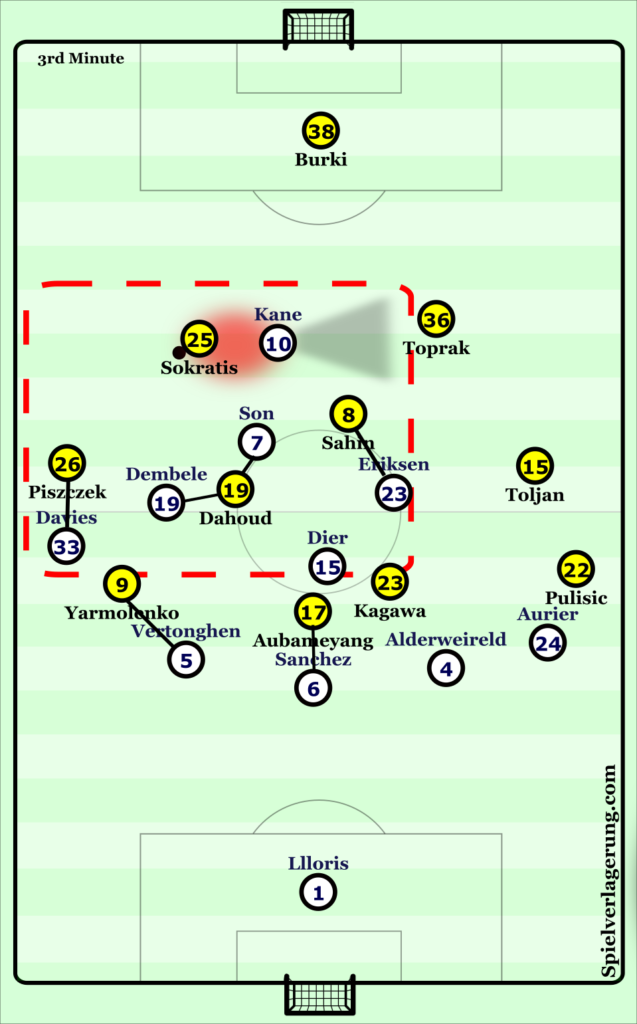
A number of man-orientations created by Tottenham’s defensive approach led to difficulties for Dortmund during build-up play
Dier and Dembele positioned themselves high up the pitch and close to Spurs’ forwards, limiting space for BVB’s midfielders to operate in and receive passes from Burki and Dortmund’s CB’s. They constituted a second pressing wave to support the pressure Tottenham’s front three applied, limiting time that Dortmund’s players had on the ball to make decisions. Spurs press was able to be played through on a singular occasion in the 10th minute due to BVB’s numerical superiority on the left wing, leading to Dier and Aurier closing the player on the ball only to leave Kagawa and Toljan unmarked in the former’s previous positions.
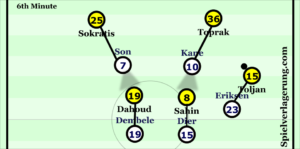
Son and Kane match-up to Toprak and Sokratis whilst marking Sahin and Dahoud in their cover shadows. Dier and Dembele position themselves behind the BVB midfielders in order to deter teammates passing to them / press quickly if the ball does reach them
Moreover, Son and Eriksen had a large amount of ground to cover defensively which created some situational problems. Son would sporadically be forced to drift over to the far right side of the pitch to maintain Spurs’ press against Dortmund’s left-sided build-up, but this would leave Pizsczek wide open in a large space to receive a switch of play and advance into, putting the defence on the back foot if BVB were able to play through Spurs’ press and reach this stage of possession. Nevertheless, these aforementioned issues were very rare.
The culmination of everything hitherto mentioned meant that Dortmund usually resorted to playing long balls forward towards the wing areas, normally resulting in the loss of possession, as they had little to no other options to play short passes and execute their favoured patient approach.
Deep Block
For the first 20 minutes of the match, Tottenham played in a 5-3-2 defensive shape. Eriksen dropped into RCM whilst Son constituted a front two alongside Kane.
Playing 5 in their defensive line was successful for Spurs, and allowed them to match-up to Dortmund suitably. As previously mentioned, Spurs WB’s predominantly marked Dortmund’s FB’s, which allowed Spurs’ outside CB’s to mark Dortmund’s inside forwards, Yarmolenko and Pulisic. They usually found themselves on the outside of Tottenham’s CB’s, making it difficult to move inside with the ball towards goal. Pulisic and Yarmolenko would usually either be forced to recycle possession or end up being tackled by Alderweireld/Vertonghen. The outside CB’s would also at times step out of the defensive line to pressurise Yarmolenko/Pulisic’s dropping movements. Playing with 5 at the back as opposed to 4 meant they could do this more so than a 4 man defence would allow due to the spaces and gaps between the defence that would be left behind.
Following the 20th minute however, the home team’s shape switched to 5-4-1 because of Son dropping from alongside Kane to the left midfield position. This change came perhaps as a result of Dortmund’s increasing ball retention and pressure on Tottenham’s defence. A greater proportion of the game was played inside Tottenham’s half, and Pochettino opted as result to play a more reactive, passive and zonal-orientated defensive style. Their second defensive line played very narrowly with little vertical space between themselves and the first defensive line, forcing BVB’s attacks to the wings, where they found it difficult to progress attacking moves.
Dortmund’s defenders were allowed much more time and space on the ball as Spurs defended inside their own half and aimed to contain. Their pressing became less aggressive, and defensive structure and compactness was prioritised. Spurs’ intention was not to try and dominate possession, instead choosing to limit space in front of their penalty box, which they accomplished to a very high standard. When Spurs were able to push out of their own half, the pressing tempo would again increase. Dembele and Dier continued to play closely to Spurs’ forwards by marking BVB CM’s, which continued to be an effective method of preventing central midfield access by complimenting the front three’s defensive positioning and movement.
When Dortmund attacked down the left hand side, Eriksen would block left half space access in midfield areas by positioning himself in a way to prevent Dortmund’s CB’s and LB Toljan to pass inside to the central midfielders. When the ball would find Toljan, Aurier would block access to Pulisic and Tottenham would shift horizontally across the pitch using the touchline as defender, which would usually force Toljan to recyle possession back to Toprak or Burki.
Furthermore, Spurs three CB’s were undoubtedly better in the air than BVB’s forwards. They were physically stronger, and Davinson Sanchez especially could match them for pace, thus allowing them to play a slightly higher defensive line. Llloris’ sweeping ability also permitted the team to play a higher defensive line, which on one occasion prevented a 1 v 1 situation with Aubameyang. Sanchez playing centre of the three centre-backs meant he was never far from Aubameyang. He was physically stronger than the Gabonese striker, intercepting and tackling him numerous times in 1 v 1 situations.
Spurs continued to break out from their defensive structure to create numerous goal-scoring opportunities from counter-attacks in the second half. They enjoyed slightly more of the ball, partially thanks to maintaining a high level of defensive intensity, resulting in their lead increasing from 2-1 to 3-1. They created higher quality chances than a possession-retention approach would have created (in all likelihood), leading to Spurs producing a very similar xG to that of Dortmund, despite BVB having the ball twice as much as Spurs. Furthermore, the chances that their counter attacks created led to a larger number of shots arising from more threatening locations than the away side were able to produce. Bosz’s team were left vulnerable in defensive transition as his side’s attacking structure consisting of high and wide FB’s as part of his 4-3-3 system left only the CB’s to provide defensive cover, leaving vast spaces for Tottenham to exploit.
Conclusion
Most teams usually struggle to play in such a reactive manner as a match goes on without making errors, but Spurs were very impressive in the way they defended and minimised mistakes. Jan Vertonghen was sent off late on for two yellow cards (one of which was awarded for a tactical foul), but it was too late to have an impact on the match’s outcome. BVB struggled to adapt their system to generate quality chances against the North Londoners, which ultimately led to Bosz being handed his first loss as Dortmund manager. This match provided more evidence for just how well-drilled and disciplined Pochettino’s side are. They have the potential to be an imposing team to play against no matter who the opponent, in both the Premier League and Champions League.



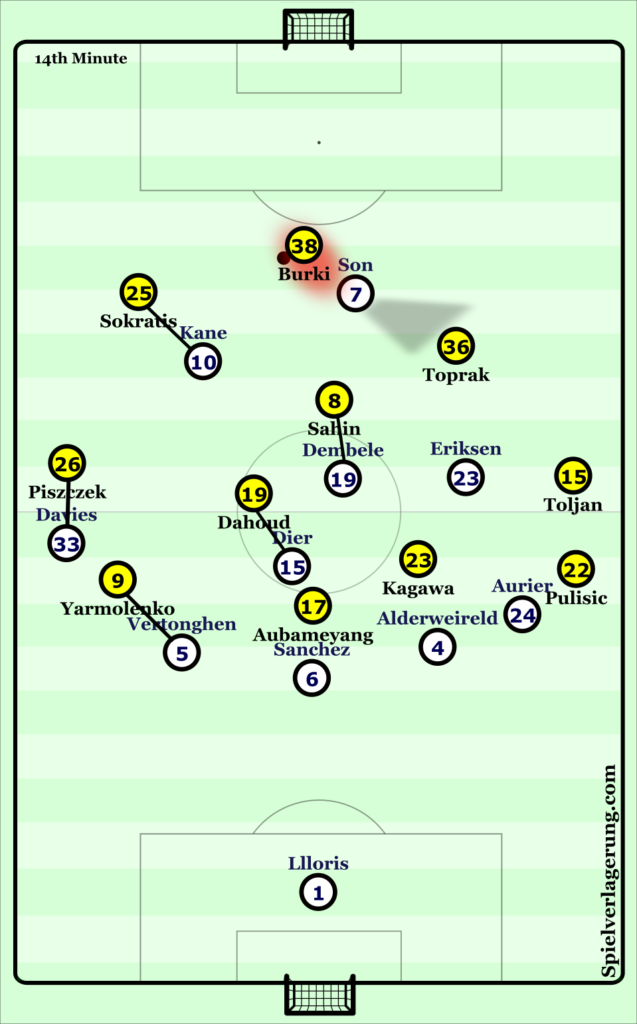
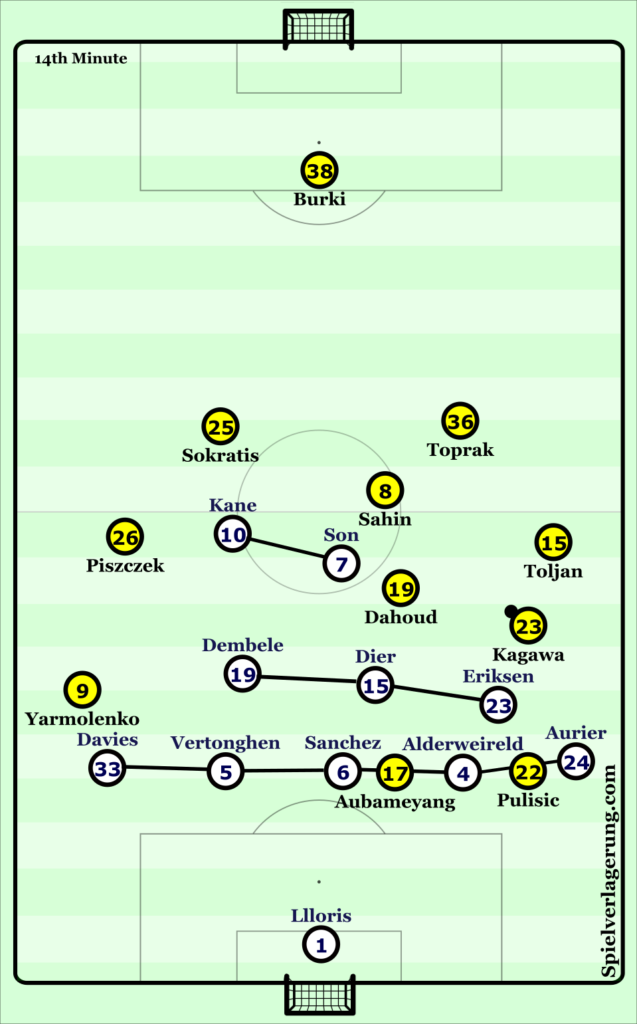
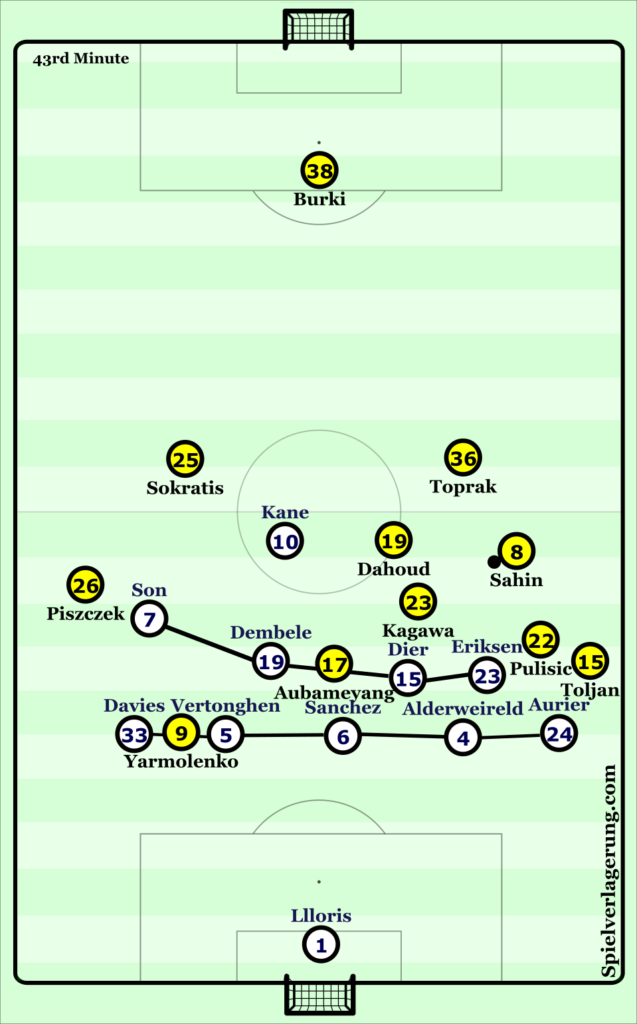
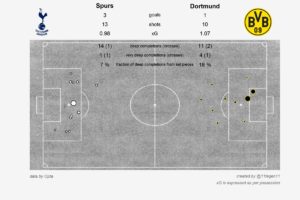
Keine Kommentare vorhanden Alle anzeigen